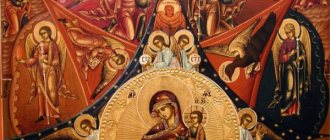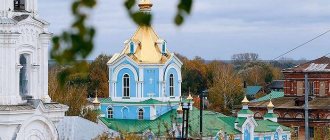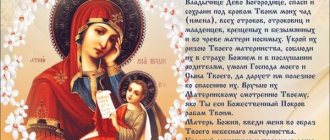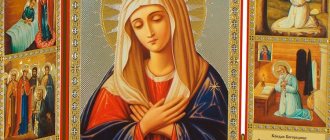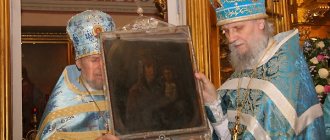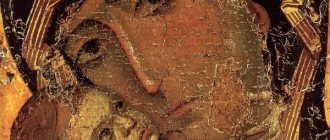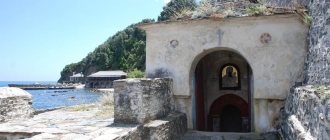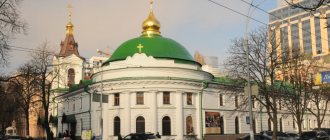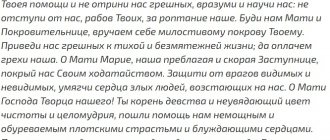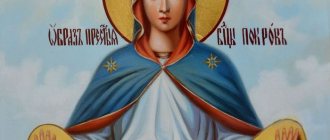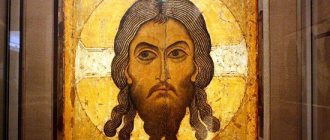In ancient times, defending independence and borders, the Russian state constantly had to fight; the entire history of Russia consists of a series of glorious battles. And the one who has God on his side wins the battle. Therefore, Russian princes and tsars did not begin a military campaign without intense prayer to God and His Most Pure Mother, the Patroness of the Orthodox land. The Tretyakov Gallery houses an ancient shrine that has survived to this day - the Don Icon of the Mother of God - a witness to the many centuries lived by the Russian people under the protection of the Mother of God.
Who painted the icon for the Kolomna church
The time and place where the icon was painted is hidden in the darkness of time. Icon painters preferred to remain anonymous, knowing that they were only an artistic instrument in the hand of God. However, the painstaking work of modern art historians suggests that the image belongs to the brush of a famous icon painter of the late 14th century. Theophanes the Greek.
Theophanes the Greek. Icon of Our Lady of the Don
Theophanes arrived in Rus' from Byzantium to decorate churches modeled on the churches of Constantinople. The time was alarming: the Golden Horde, led by Mamai, was preparing to punish Prince Dmitry Ioannovich for refusing to pay increased tribute, and at the same time destroy the Christian churches hitherto tolerated by it and convert the people to a different faith.
In preparation for the decisive battle, the troops gathered in Kolomna near Moscow, from where they marched to the Don. With them they carried the icon of the Mother of God “Eleusa”, which in Greek means “Merciful”. Presumably, it was written by Theophanes the Greek shortly before the glorious events, for the Assumption Church in the village. Kolomna. The image was mounted on a high shaft; on its reverse side the scene of the Dormition of the Mother of God was depicted.
Reverse image
Like many ancient icons, this painting is double-sided. Its reverse, preserved in good condition, depicts the Assumption of the Virgin Mary. In the center of this composition there is Christ, who is depicted much higher than the other characters. In his hands the Savior holds the symbol of the immortal soul of the Virgin Mary, which looks like a tiny swaddled figure.
The action conveyed by the author of the picture takes place indoors. In front of the Savior there is a bed where the deceased Mother of God lies. The Virgin Mary is depicted surrounded by twelve drooping apostles and two bishops who witnessed Her death in Jerusalem. In front of the deathbed there is a burning candle, which symbolizes the extinction of earthly life.
Compared to the main drawing, the reverse side of the icon is designed in darker colors. She is distinguished by great impulsiveness, flat color and clear boundaries. The faces of the apostles are simple, devoid of aristocracy, traditional for the works of Byzantine icon painters. Many researchers believe that the front and back sides of the relic were created by different authors.
Mother of God - Defender of the Russian Land
Under the shadow of Russian banners and the blessing of the Mother of God, the Mongols were defeated. The icon that took part in the battle was honorably delivered to Kolomna and placed in the Assumption Church, built by Prince Dmitry in honor of the victory over the hated yoke. For almost two centuries, the image of the Mother of God, which did not have a name at that time, was consecrated by the prayers of the people who flocked to it.
Holy Blessed Grand Duke Dmitry Donskoy. Church of the Intercession of the Blessed Virgin Mary in the village of Volkovichi
During the reign of Ivan the Terrible, Prince Dimitri, who defeated Mamai, began to be called Donskoy, and the ancient shrine from the Kolomna Church began to be called the “Don Icon of the Mother of God.” Following the traditions of his ancestors, Grozny prayed before her when preparing to go on a campaign to Kazan.
And again the Most Pure Mother of God did not abandon the Russian army, begging the Lord for victory. After this, the tsar ordered that the image be transferred from Kolomna to a more honorable place - to the Annunciation Cathedral of the Kremlin. So the icon of the Don Mother of God became a national shrine.
What requests do people come to the icon with?
There has long been a tradition according to which soldiers who stand for a just cause and save their Fatherland pray in front of the Don Icon. The Mother of God image is considered a strong patron of Russia, to whom people turn for support during wars or armed conflicts, with requests to protect the borders of the state. The shrine helps those who master military professions and allows them to achieve better results in their studies.
Orthodox Christians come to pray in front of the shrine and ask for help in various life situations:
- if you want to be healed from a serious illness, ask for health for your children or loved ones;
- in case of conflicts in the family, lack of mutual understanding between spouses, parents and children;
- in case of threats from ill-wishers, fear for one’s own life or the safety of relatives;
- with weakening faith, mental turmoil, inability to resist temptations.
The prayer to the Don Icon of the Mother of God is read at any time of the day. In particularly difficult circumstances, one should turn to the Most Pure Virgin every morning and evening.
They ask the Mother of God for help in their own words or read akathists found in Orthodox prayer books. If possible, you should regularly attend prayer services in the temple.
When praying at the Don Icon at home or in church, they must light a thin sacred candle. After the prayer, you need to cross yourself twice according to Orthodox custom, kiss the hand or the edge of the garment of the image on the icon, and make the cross again.
Moving the shrine from Kolomna to Moscow
With tears, the residents of Kolomna saw off their beloved Mother of God the Merciful, before whom their fathers and grandfathers prayed. Seeing the grief of the people, Ivan the Terrible ordered two accurate lists to be made, which were installed in the Assumption Church and at the gates of the city.
About other holy places in Moscow:
- Church of Lazarus and the Nativity of the Virgin Mary
- Church of the Intercession of the Virgin Mary in Fili
- Trinity Church in Nikitkiny
The icon stayed in the Annunciation Cathedral of the Kremlin only in times of peace, constantly participating in campaigns with the Russian army against the Livonians, Polovtsians, Kazy-Girey, who was already standing under the walls of Moscow and for unknown reasons fled without engaging in battle. The victories of Prince Golitsyn and the capture of Azov are also associated with the intercession of the Mother of God, before whose image the governors prayed.
Blagoveshchensky cathedral
Every year, in memory of the victory, solemn religious processions were held on the Kulikovo Field, when the miraculous image in a precious robe walked from the Annunciation Cathedral to the Donskoy Monastery. This monastery was built on the very spot from which the Crimean Khan Kazy-Girey fled. Another copy of the Don Icon, which has survived to this day, was made for the monastery. The two holy images met during a solemn service and a large gathering of people.
Interesting. As a sign of the bounty of the Mother of God, the frame of the icon was decorated with many precious stones, pectoral crosses and panagias, but the best decoration were the reliquaries - repositories for particles of holy relics cut into the butt of the image.
The history of the origin of the Don Icon
The Don Icon of the Mother of God more than once saved Russia in difficult times, helping princes and generals win the war against the invaders. Over its centuries-old history, the image has demonstrated its miraculous power so many times that no Christian has any doubt about its divinity. This most holy icon is illuminated by God's grace, which extends to all believers who pray before it.
The victory of Dmitry Donskoy in the Battle of Kulikovo is associated with “Donskaya”. There is a legend that the Cossacks gave this image to the prince before the battle with the Tatars. True, many historians refute this version, because in those days the Cossacks did not yet exist. Although Christians believe that it was the intercession of the Immaculate Virgin that helped the Russian army defeat the hordes of the Tatar Khan Mamai.
The very name “Don” icon received only in the 16th century. At first, the Assumption Kolomna Church, built by Dmitry Donskoy, and then the icon kept in it were renamed Donskaya.
For some time, the shrine was kept in the Simonov Assumption Monastery, in the 16th century it was transferred to the Annunciation Cathedral of the Moscow Kremlin. Some historians suggest that the image was kept in the Assumption Cathedral of Kolomna. It was in front of this icon that Ivan the Terrible himself prayed before the Kazan campaign. Later, the holy image helped defend Moscow from the Tatar khan Kaza II Giray. In honor of the miraculous power coming from the icon, the Donskoy Monastery was erected, for which a copy of the “Donskoy” was specially painted.
At the end of the 16th century, Boris Godunov was blessed for the kingdom in this image. In the 17th century, Prince Vasily Golitsyn took the shrine with him on a campaign. At the end of the 17th century, the image was kept for some time in the chambers of Princess Natalya Alekseevna, and then the icon was returned to the Annunciation Cathedral. When Napoleon's troops arrived in Moscow, precious stones disappeared from the frame of the most holy image. During the years of the revolution, the ancient image was moved to the Historical Museum. Since 1930, the icon has been kept in the collection of the Tretyakov Gallery. The church established a holiday in honor of the shrine. Every year on September 1, the image is brought to the Donskoy Monastery and a festive service is performed in front of it.
There are several versions regarding the authorship of the icon. Some historians suggest that the image was painted by Theophanes the Greek himself or one of his masters. There is a version that the icon was painted by Ignatius the Greek. Perhaps the shrine was created by a Serbian master of the Moravian school.
Each researcher notes the high quality of work, which only a few artists of that time were capable of, for example, Feofan or his students. The time of creation is the end of the 14th century. Perhaps the icon was commissioned by Princess Evdokia, the wife of Dmitry Donskoy, during the war with the invaders in order to pray and ask the Mother of God for intercession.
From the Annunciation Cathedral to the Tretyakov Gallery
During the capture of Moscow by Napoleon, the shrine was robbed by the French, but remained in its place, to the left of the royal doors of the Annunciation Cathedral. There she survived the revolution of 1917: the Mother of God did not abandon her people both in years of joy and in hard times. When most of the revered miraculous icons were destroyed during the destruction of churches, the Don Icon was saved by God's providence and the workers of the State Museum. Later, in 1930, it was placed in the Tretyakov Gallery, where it remains today.
Our Lady of the Don in the Tretyakov Gallery
Where can I find the lists?
The original “Donskoy” is kept in the Tretyakov Gallery. A huge number of copies have been drawn, which are located in various churches in Russia. Each list has miraculous power and helps on difficult days. There is the oldest copy of “Donskoy”, made at the end of the 14th century. The frame of this image is decorated with silver and gilding. For some time, the ancient list was in the Trinity-Sergius Lavra. Prince Vladimir Andreevich, brother of Dmitry Donskoy, donated a copy to the monastery. Later the icon was moved to Moscow. Then they made two lists and sent them to Kolomna. One copy was kept in the Assumption Cathedral to this day.
In ancient times, when it was possible to protect Moscow from the troops of the Crimean Khan Kazy-Girey, they made a list for the Donskoy Monastery, built in the places of battle with the enemy. An ancient copy, along with the original, is kept in the Tretyakov Gallery. Currently, the Donskoy Monastery has copies of the most holy image made in the 17th century.
Resumption of religious processions
In 1994, it was decided to resume the tradition of religious processions to the Donskoy Monastery. The shrine is over 600 years old; generations of restorers have worked to preserve it. Bringing a valuable exhibit out of the quiet atmosphere of a museum to the multitude of people waiting for it was not an easy decision. But as a result of the joint work of many specialists, this became possible.
Every year, a few weeks before September 1, the day of the celebration of Our Lady of the Don, restoration scientists and specialists from the polymetallic plant prepare a special capsule where constant humidity and temperature are maintained. Preparation of transport, escort and protection of the shrine also require a lot of work and worry.
Donskoy Monastery
On the day of the holiday itself, many people and clergy anxiously await the arrival of the shrine on the threshold of the Donskoy Monastery Cathedral. Finally, while the “magnification” is chanted, the closed case is taken out of the car: the exhibit can be damaged by bright daylight and even street noise. In the temple, next to the revered copy of the Don Icon, a case decorated with white flowers is already waiting. The case is placed underneath it and, using special devices, the capsule with the icon is slowly pushed inside the icon case. The ancient face of the Mother of God rises above those praying in reverent silence, giving the gathered people unforgettable moments.
Where temples were built in the name of the shrine
Several such places are widely known in Russia:
- Temple of the Don Icon in Perlovka near Moscow. Construction was carried out on the initiative of the nobleman N. S. Perlov and was completed in 1897. The distinctive features of this building are its square shape, a tent-shaped dome with triangular kokoshniks. During the Soviet era, the temple was partially destroyed, but with the advent of the 90s. it was completely restored;
- two cathedral churches of the Don Icon in the southwestern part of Moscow. In the past, a religious school and an icon-painting workshop functioned here. After the revolution, the churches were closed and began to operate fully only in 1991. Periodically, religious processions are held to them, during which the original painting is delivered from the Tretyakov Gallery.
The Don Icon of the Mother of God is an ancient shrine that is of great importance for all believers in Russia. The miraculous face of the Mother of God is carefully preserved in their hearts by millions of Orthodox people.
The relic is venerated on September 1. Since 2010, by decision of His Holiness Patriarch Kirill of Moscow and All Rus', this day is also considered the official Orthodox holiday of the Russian Cossacks.
Iconographic images and their symbols
The original Donskaya Icon depicts the Most Holy Virgin holding in her right hand the Infant of God, clinging to Her. The head of the Mother of God bowed towards her Son, her sad and stern gaze was directed at those praying. On Her face is a sorrowful premonition of the tragedy awaiting Christ. In composition, the icon resembles the Vladimir icon, differing from it in the position of the Baby’s legs.
The Virgin Mary is covered with dark red maforia, decorated with gold stripes, three stars and fringe - symbols of ever-virginity and royal status. Under the maforia one can see a dark blue chiton and a shawl covering the hair. In the left hand, under the legs of the Infant God, you can see the board. On later lists he was depicted as white. With this cloth, the Mother of God wipes away the tears of those who flow to Her in need.
Iconographic image of Our Lady of the Don
The Divine Infant is dressed in an ocher chiton. The golden rays of “gaps” scattering across the folds are a sign of Divine grace. In his hand the Baby holds a scroll - a symbol of the Old Testament Law, which lost its meaning with the Nativity of Christ.
The background of the icon and the halos above the heads of the saints are made of the finest gold leaf, erased by time. Gold is not just a rich decoration: it points to the Upper World, filled with Divine light. One can imagine how majestic the icon looked immediately after it was painted.
Interesting. On April 21, 2015, a newly completed copy from the ancient shrine was consecrated in the church at the Tretyakov Gallery. At the request of the residents of Southern Russia, it will be placed in the main cathedral of Rostov-on-Don.
Description and meaning in Orthodoxy
The most holy image called “Donskaya” is double-sided. The image of the Mother of God on it is on the front side and on the back. True, the subject matter in the paintings is different. The front side depicts the Mother of God, with the Baby, the future Savior, clinging to her cheek. Initially, holy figures were drawn on a golden background. In the original, which has survived to this day, the halos around the heads of the Mother of God and her Son have not been preserved. In the drawing, the Immaculate Virgin supports with her right hand the Holy Child, who is tightly pressed to her body.
Jesus Christ blesses people with his right hand. In the left hand of the Savior, which lies on the knee, covered with a himation, there is a rolled scroll. The baby's legs, bare to the knees, are on the wrist of the Virgin.
The Immaculate Virgin is dressed in cherry-colored maforium. Her clothes are decorated with embroidered stars and fringe. On the head of the Mother of God is a blue cap. The Holy Infant is dressed in an ocher chiton, decorated with a blue sewn decoration. The Savior's clothing is replete with golden touches. The rolled scroll that the Lord holds is tied with a golden cord. The image is imbued with reverence and Divine power. There is sadness on the face of the Mother of God, as if she foresees the tragic death of her son. At the same time, the icon touches with its kindness, warmth, and gentleness.
On the reverse side of the shrine is the Assumption of the Virgin Mary. Unlike the drawing on the front, this image is perfectly preserved. In the center of the composition is the deceased Mother of God lying on a bed. Jesus Christ stands next to her and holds her soul, symbolically shown in the image of a baby in swaddling clothes. The bed of the deceased is surrounded by 12 apostles and 2 bishops. Before the deathbed of the Mother of God there is a burning candle, symbolizing the extinction of life. Sorrow is visible on the faces of the apostles, because they came to say goodbye to the Mother of their Teacher.
The holy icon was painted in those distant times, when the Russian people had to constantly fight invaders and defend their lands from the raids of nomads. Every time before a battle, believers prayed in front of the image and asked it to help them win. The Immaculate Virgin always helped those who prayed. The Mother of God was revered for all her mercies, and the image was considered miraculous.
What does an icon help with?
The Don Icon is one of the ancient images revered in Rus'. Traditionally, warriors, defenders of the Fatherland, and soldiers were blessed to pray before her. This image was considered protective for Rus'; they resorted to it in any wars or conflicts. However, this does not mean at all that ordinary Orthodox Christians cannot turn to the Mother of God for help in front of the Don Icon.
Help in any of our questions, which we address through prayer to the Lord, comes not from the icons themselves, but directly from the Most Holy Theotokos, whose image we see on this or that icon. No matter what face we pray to, all our petitions go to the Queen of Heaven herself.
What do they ask for before the image?
The Don Icon with the Mother of God and the Holy Child depicted on it is considered miraculous. It was sanctified by the Almighty himself. Christians believe that by praying in front of the shrine and sincerely repenting of their sins, people can ask the Immaculate Virgin for mercy. After all, the Mother of God can beg her Son not to strictly punish sinners, to have mercy on them and grant them salvation. People pray in front of the icon when times get tough. The most holy image helps to protect the country from enemy attacks and to defeat the enemy. Prayer to the Mother of God puts enemies to flight and saves the lives of soldiers.
The Immaculate Virgin is approached for a blessing before starting a new business. Our Lady is asked to protect people during the journey. Believers pray that the Mother of God will deliver their souls from sin, guide their children on the righteous path, and support the elderly in their old age. The Mother of God is asked to help cure illnesses, soften an evil heart, and give everyone peace, tranquility and love. People turn to it when they want to reconcile those at war or justify those who have been slandered. Believers ask the Mother of God to cover them with her veil, protecting them from fire, sword, and evil intent.
Donskoy Church in Perlovka
From the icon, which became a symbol of Russian history, many copies spread throughout Rus'. Temples were erected in her honor: in every remote settlement people wanted to worship their beloved image, pray for an end to troubles and wars. One of these temples was the Don Church, built at the end of the 19th century by the hereditary nobleman Nikolai Semenovich Perlov not far from Mytishchi. A small but elegant wooden church was intended for summer residents who wanted to attend divine services in the summer.
Donskoy Church in Perlovka
No one imagined that the modest dacha community would be sanctified with martyr’s blood: the priest of the church, Georgy Izvekov, a well-known church composer, would be arrested and shot in 1937 at the Butovo training ground. The temple itself was closed several times until it was destroyed to the foundation. “We have to endure all kinds of hardships - all this was sent to us as punishment for our sins,” Fr. correctly noted. George in his last speech before his death.
Through the incessant prayers of the Mother of God and the mercy of the Lord towards the penitent, the Perlovskaya Don Church is now being revived. Soon the refined silhouette of its dome, recreated from old photographs, will again decorate the stop of the Yaroslavl Railway. It is no longer summer residents who will flock to the revered temple icon of Our Lady of the Don, but residents of the big city. And at the present time there is something to pray to the Mother of God, Guardian of the Russian borders.
You can also pray at this image in the following churches in Russia:
- Donskoy Monastery in Moscow
- Temple in honor of the Don Icon of the Mother of God in Rostov-on-Don;
- Epiphany Patriarchal Cathedral in Moscow;
- Church of the Life-Giving Trinity on Sparrow Hills;
- Temple of the Deposition of the Robe, Moscow.
What is the secret of the master’s originality?
The icon painter was born in Byzantium in 1337. The exact date of death is unknown: according to various sources - around 1405. It was from his place of origin that he received the nickname (or surname) - Greek.
Before arriving in Rus', the artist worked in Constantinople and its suburbs. And in 1370, Theophanes settled in Novgorod. He had a huge influence on the development of Novgorod art.
Later he moved to Moscow, where he continued to express himself in painting private houses and churches, painting icons, and decorating Christian literature.
Characteristic features of the creative style of the talented icon painter Theophanes the Greek are expressiveness and an incredible combination of colors. At the same time, the glorification of earthly beauty and the greatness of spiritual life are harmoniously combined, which pays sadly little attention to external manifestations.
Such a distinctive feature of the Master as “cursive writing” aroused particular admiration among his contemporaries. When painting the next picture, Feofan did not particularly try to convey the features of the sample. Each of his works has its own unique features. Each face is endowed with its own character and each stroke showed the world a brilliant work, such as “Our Lady of the Don” by Theophanes the Greek and his “Assumption of the Virgin Mary”.
Feofan's biography still has its blind spots, raising many questions. Neither the exact date of his birth nor his death is known. Born in Byzantium, how did he get to Russian soil?
History connects his name with the name of Metropolitan Cyprian, but all this is mainly just speculation about the talented icon painter, an artist who glorified his name in painting miniatures and frescoes on religious themes when painting churches.
Prayers to the Mother of God Donskaya
Since ancient times, the Most Holy Theotokos has been the patron of the Russian army. There is a legend among the Don Cossacks that it was through them that the image got into the army of Dmitry Ioannovich. Marching icons take part in military religious processions and in prayer services on the occasion of taking the oath in the Cossack troops. In Rostov-on-Don, a spring was consecrated in honor of the image of Donskoy.
Healthy. Despite the “military” purpose of the icon, most of the prayers offered in front of it are about peace. People associated with the diplomatic profession pray to Our Lady of the Don.
The Akathist to Our Lady of the Don was written at the end of the 19th century. This is a solemn chant commemorating the victories of the Russian army, won through the intercession of the Most Holy Theotokos. Particular attention is paid to the image of the Assumption, placed on the reverse side of the marching icon. Reading the akathist at home will decorate the prayer and strengthen spiritual strength.
Other akathists to the Mother of God:
- In front of the Peschanskaya icon
- In front of the icon “Tree of the Blessed Virgin Mary”
- "To the Chosen Voivode"
Troparion, tone 4
Intercessor of the faithful, Most Blessed and Swift, Most Pure Virgin Mary! We pray to You before Your holy and miraculous image, that just as You bestowed Your intercession on the city of Moscow from ancient times, so now You graciously deliver us from all troubles and misfortunes and save our souls, like the Merciful One.
Kontakion, tone 8
To the chosen Voivode, victorious,/ as having been delivered from the evil ones,/ let us sing thanks to Ti, Thy servants, to the Mother of God,/ but, as having an invincible power,/ free us from all troubles, let us call Ti // Rejoice, Unmarried Bride.
Kontakion, tone 2
You have moved into the heavenly abodes with your flesh, / you have left no existence on earth, O Mother of God, / you have granted the divine and many-wonderful image of your Most Pure Face / to behold and worship those who love you, / as a sign of your grace; / we honor it with kisses.
Prayer before the icon
Oh, Most Holy Lady, Virgin Mother of God, our good and speedy Intercessor. We sing thanksgiving for Your wonderful deeds, we sing songs of praise from ancient years to Your inescapable intercession for the city of Moscow and our country, which has always been revealed. The alien regiments take flight, cities and towns remain unharmed from the fire, and people are delivered from cruel death.
The teary eyes are dried up, the lamentations of the faithful are silenced. Sadness is transformed into universal joy. Bring us consolation in adversity, a revival of hope, an image of courage, a source of mercy, and grant us inexhaustible patience in sorrowful circumstances. Give to each one according to his request and his need.
Raise babies, teach chastity and fear of God to young ones, encourage the sad and support weak old age. Soften evil hearts, fill us all with peace and love. Destroy the vices, so that our sins do not rise before the Judge of all, so that the righteous wrath of God does not befall us. With your protection, protect us from the invasion of enemies, from famine, sword, fire and all other suffering.
We hope through Your prayers to receive forgiveness of sins from the judge God and, after our death, to the right hand of the throne of glory, where You stand before the Holy Trinity in eternal glory. Oh, all-sung Virgin, deign us, with the face of angels and saints, to praise the most honorable Name of Your Son with the Beginningless Father and the Life-giving Spirit forever and ever. Amen.
Prayer before the icon
Oh, All-Merciful Mother, Most Pure Virgin Mary, You are the light of my mind, the joy of my heart, the strength of my will. Hear and accept my prayer. Look at the ulcers of my soul and body. The forgotten sins of youth and hidden sins aggravate my conscience. Washed me with streams of tears, remove the heavy burden, strengthen me, so that I may create fruits worthy of repentance, my path is strewn with thorns of sorrows.
We know that God’s truth is punishing me—beg God’s mercy for me. Look at my groaning and correct my path, and save me and my children and my neighbors. Be me a treasure of faith and a repository of piety. Grant indestructible patience in troubles, which flows from faith.
Drive out anger, envy, despondency, memory-malice, uncleanness, laziness: with these and greater vices my soul is ill. Reconcile those who are at war, justify those who are slandered, enlighten us with the light of Your Son, and grant us to speak to our friends the word of truth, firm in truth, peaceful for the sake of love, dissolved in prudence.
Visit the illnesses and sorrows of those who exist. May we preserve everything under Thy sovereign protection, and may we comfortably reach the Kingdom of Heaven, giving praise for everything to God, the lover of mankind, always, now and ever, and unto the ages of ages.
Deviations from Byzantine canons
It should be noted that, according to most art historians, the icon painter Theophanes the Greek (Byzantine by origin) in his work went beyond the established traditions of the Constantinople school, whose masters did not allow themselves to violate established canons in creative experiments. The Don Icon of the Mother of God is a striking example of this.
To give the Virgin's facial features greater vitality and expression, the artist allows for some asymmetry in the position of the mouth and eyes. They are not parallel, as on the icons of Byzantine masters, but are located along descending axes. In addition, the mouth is slightly shifted to the right.
These seemingly insignificant details, used by the author for purely technical purposes, were, nevertheless, a violation of the canons established by the Church of Constantinople, and were considered unacceptable in Byzantium. And there are many such examples in the icons and frescoes painted by Theophanes the Greek. “Our Lady of the Don” is one of them.
Image location and lists
The original of the holy image has survived to this day. The face of Our Lady “Donskaya” can be seen with your own eyes in the Tretyakov Gallery. On the day of veneration, the shrine is brought to the Donskoy stauropegic monastery, where divine services glorifying the image are held annually.
The original is in the Tretyakov Gallery
On the eve of the day of veneration, the icon is transported to the Donskoy Stavropegic Monastery
Celebration of the Holy Image of the Virgin Mary
Not only the original, but also the copies of the holy image have special power. The most revered copies of the Don Icon of the Mother of God by Orthodox Christians are located in the following churches of God:
- Donskaya Church in Perlovka (Mytishchi, Moscow region);
- temple in the city of Starodub (Bryansk region);
- parish church in the city of Lipetsk;
- Church of the Exaltation of the Holy Cross (Tula).
Discussions surrounding the authorship of the icon
It is characteristic that the scene depicted on the reverse side of the icon contains obvious deviations from the traditions of Byzantine painting. This is primarily evidenced by the faces of the apostles, devoid of the features of aristocracy characteristic of the traditions of Constantinople. As many researchers of the work of Theophanes the Greek emphasize in their works, they are more characterized by purely peasant traits, common among the common people.
It is not surprising that the multiple differences between the works of Theophanes the Greek and the canons and artistic traditions of Byzantium gave rise to a number of art critics doubting the authorship of the works attributed to him. Their point of view is quite understandable, because on the banks of the Bosphorus the artist was not only born, but also formed as a master of icon painting - we should not forget that he came to Rus' at the age of thirty.
His style of writing is closer to the Novgorod school than to his native Byzantine one. Many years of discussions on this issue continue to this day, but they are dominated by the opinion that, finding himself in a new country for him and having the opportunity to see many old icons created by Russian masters, the artist used their characteristic features in his work.
